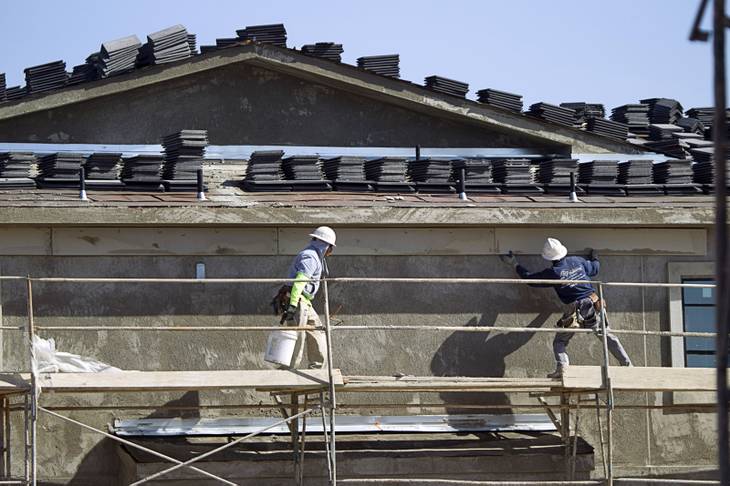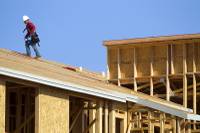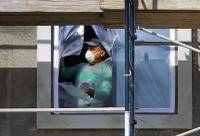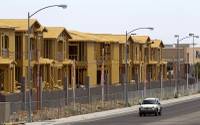When Las Vegas’ construction industry was white hot last decade, few places grew as fast as the southwest valley.
Buoyed by new freeway access and Wall Street’s easy money, investors flipped land for profit and built subdivisions, strip malls, office buildings and hospitals, with even more plans for an area that years earlier was largely open desert. But business plunged with the recession.
Today, as the economy improves, few places are getting as much action. Developers are building or planning to construct apartment complexes, industrial properties, big-box retail and single-family homes around the 215 Beltway between Interstate 15 and Flamingo Road.
The area is far from booming, and there remain huge tracts of raw land throughout the southwest, most of which likely won’t be developed anytime soon. And not everyone is cheering the current workload amid fears that some investors are piling in too quickly and overbuilding again.
But overall, the resurgence highlights the steady comeback of a once-battered industry that, for many people, offers visual evidence that Southern Nevada’s sluggish economy is on the mend.
In June 2006, near the height of the real estate bubble, 112,000 people in the Las Vegas area worked in construction. That number plunged 69 percent to 34,800 workers in early 2012, according to the Associated General Contractors of America.
Today, 48,500 people work in construction locally, up 39 percent from the depths of the recession.
“We know the worst is past us, and that gives people confidence,” said Scott Gragson, a land broker and investor.
Projects underway or on the drawing board in the southwest include:
■ IKEA’s 351,000-square-foot furniture superstore, which broke ground April 9 and is slated to open in summer 2016
■ Panattoni Development Co. partner Doug Roberts’ two-building warehouse project, Jones Corporate Park, which is scheduled to break ground this month
■ Australian slot-machine maker Ainsworth Game Technology’s 300,000-square-foot Americas headquarters, poised to open by mid-2016
■ The Molasky Group of Companies’ two-story, 110,000-square-foot industrial building at the UNLV Harry Reid Research and Technology Park, which the company plans to lease to prescription-drug manager Catamaran Corp.
■ At least a dozen apartment complexes and thousands of single-family homes.
Developers are drawn to the area for several reasons. There is plenty of land, it’s a quick drive to the Strip and to McCarran International Airport, and it’s roughly equidistant from Summerlin and Green Valley, two of the valley’s most popular residential areas.
Rent in several sectors — apartment, office, industrial and retail — typically is higher and vacancy rates are lower in the southwest than in other parts of the valley with lots of land, including the northwest and North Las Vegas.
Moreover, Clark County commissioners in May 2013 voted unanimously to open roughly 3,600 acres, mostly in the southwest, to potential residential and other development. Airplanes, thanks to advanced technology, aren’t as loud as they used to be, so the county agreed to shrink McCarran’s noise contour.
IKEA executives had been eyeing the Las Vegas market for almost 10 years, waiting for the population to pass 2 million, and were “very much focused” on sites along the Beltway with good visibility and access, spokesman Joseph Roth said.
The popular Swedish retailer needed a large site for its megastore. Land ownership in the southwest is fractured heavily, so assembling a big tract can be a headache. The spot IKEA wanted, 26 acres at the southwest corner of South Durango Drive and West Sunset Road, was owned by one investor, and the chain paid a hefty price for it: $21.3 million.
The sale, by M.J. Dean Construction founder Michael Dean, closed in December. IKEA paid $819,328 per acre. Valleywide last year, land investors paid an average $276,422 per acre, according to brokerage firm Colliers International. Roth said the company paid “a fair price” for the property.
Meanwhile, Ainsworth CEO Danny Gladstone decided a few years ago he wanted to build the company’s Americas headquarters near the southeast corner of South Jones Boulevard and West Sunset Road, said Mike Dreitzer, the company’s president of North American operations.
Site work is underway. When finished, the property will have warehouse and manufacturing space, as well as offices for sales, marketing and finance personnel. It’s close to customers and the airport, and just 2 miles east of rival International Game Technology’s campus.
“We think it really is the new center of the gaming equipment manufacturers’ corridor,” Dreitzer said.
For large projects, though, the biggest source of development in the southwest is apartments.
Investors have been buying rental properties throughout Southern Nevada at a fast pace in recent years. The valley’s economic collapse created a big pool of potential renters by wreaking havoc on residents’ finances. Foreclosures, bankruptcies and short sales swept through the region, making it impossible for many people to obtain a mortgage, let alone afford a down payment.
Apartment construction lagged investment sales, but now it’s picking up speed. After opening just 367 units valleywide in 2013, developers completed about 1,700 units last year. As of December, they were projected to open roughly 5,750 units this year and almost 2,000 more in 2016, according to brokerage firm CBRE Group. Among current or planned projects, roughly 50 percent of the new units are in the southwest valley.
But developers may be getting ahead of themselves. They are building faster than demand calls for, RCG Economics principal John Restrepo said.
“It’s a great location, (but) that’s a little too much at one time,” CBRE broker Spencer Ballif added.
Nevada West Partners is the biggest developer in the southwest, with five projects totaling 1,600 units planned or underway. Partner Martin Egbert, whose group has developed apartments in the valley since the late 1980s, said he isn’t concerned investors might be overbuilding and possibly pushing down rental rates. Properties his group opened in recent years — often higher-end residences with lots of amenities — are almost fully occupied and command big prices, he said.
Homeownership rates nationally are at record lows, he said, partly because more people who can afford to buy are choosing to rent instead.
“They’ve seen the swings in real estate prices ... and they like the flexibility afforded by being a renter,” Egbert said.
The southwest’s fast-paced growth started around the early 2000s when the Beltway expanded, offering freeway driving instead of dusty back roads. Investors flipped land and built properties, but work ground to a halt when the recession toppled the valley, leaving the southwest a checkerboard of open desert, finished projects and abandoned construction sites.
“Nobody was doing anything,” CBRE broker Greg Tassi said.
Projects got stuck on the drawing board, too, including Station Casinos’ Durango Station resort on Durango Drive just south of the Beltway.
In September 2008, less than two weeks before investment firm Lehman Brothers collapsed, helping to trigger the U.S. financial crisis, Station spokeswoman Lori Nelson said the resort tentatively was scheduled to open in 2011. “The plans are done, they are ready to go, and it will really be contingent on timing based on the economic conditions,” she said at the time.
Today, the land is undeveloped, and a Station sign there advertises plans for a 120,000-square-foot casino with 1,000-room hotel. The sign also warns “No Dumping — No Trespassing.”
Nelson said this month the company has no development timeline for the site.
At the peak of the bubble, land in the southwest valley frequently sold for $1 million an acre. Today, listing prices are a fraction of that but rising, typically ranging from about $300,000 an acre to $700,000 per acre, Gragson said.
One line of business that boomed with the Beltway was home construction. The southwest has been the top submarket in the valley ranked by homes sold for about 10 years, Home Builders Research President Dennis Smith said.
Builders sold 2,016 homes there last year, a third of all new-home sales in Southern Nevada, he said. The second-best market, the northwest, had 1,520 sales.
Perhaps the biggest project in the southwest before the freeway expansion was developer Jim Rhodes’ sprawling Rhodes Ranch community on South Durango Drive at West Windmill Lane.
“It was considered to be out in the middle of nowhere,” Smith said. “But the Beltway changed that.”




